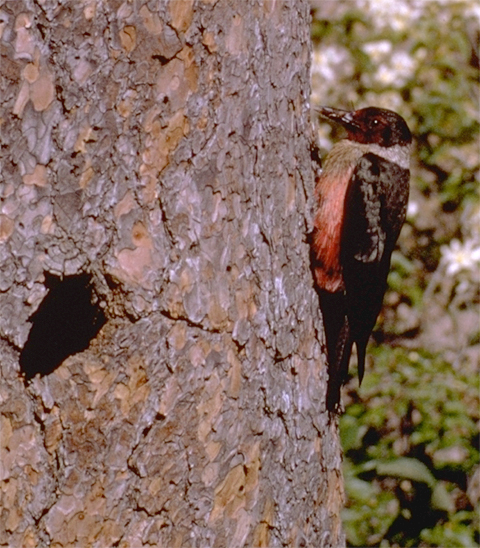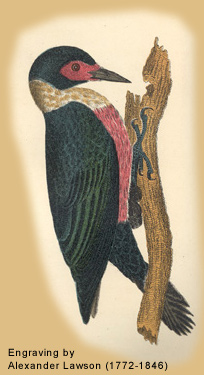Melanerpes lewis
From Wilson’s American Ornithology[1]Alexander Wilson, American Ornithology or, The natural history of the birds of the United States: Illustrated with plates, engraved and colored from original drawings taken from nature, 9 vols. … Continue reading
Engraved by Alexander Lawson (1772–1846)
Lewis’s Description
On 27 May 1806, while the expedition was camped in the vicinity of modern Kamiah, Idaho, on the Clearwater River, biding their time until they could take to the snow-choked Indian trail across the Bitterroot Mountains, Lewis described a bird that was “new to science,” with his typical mixture of minute detail and genuine admiration:
The Black woodpecker which I have frequently mentioned and which is found in most parts of the roky Mountains as well as the Western and S. W. Mountains, I had never an opportunity of examining untill a few days since when we killed and preserved several of them. This bird is about the size of the lark woodpecker or the turtle dove, tho’ it’s wings are longer than either of those birds.
The beak is black, one inch long, reather wide at the base, somewhat curved, and sharply pointed; the chaps are of equal length. Around the base of the beak including the eye and a small part of the throat is of a fine crimson red. The neck and as low as the croop in front is of an iron grey. The belly and breast is a curious mixture of white and blood red which has much the appearance of having been artificially painted or stained of that colour. The red reather predominates.
The top of the head back, sides, upper surface of the wings and tail are black, with a glossey tint of green in a certain exposure to the light. The under side of the wings and tail are of a sooty black. It has ten feathers in the tail, sharply pointed, and those in the centre reather longest, being 2-1/2 inches in length. The tongue is barbed, pointed, and of an elastic cartelaginous substance. The eye is moderately large, puple black and iris of a dark yellowish brown.
This bird in it’s actions when flying resembles the small redheaded woodpecker common to the Atlantic states; its note also somewhat resembles that bird. The pointed tail seems to assist it in seting with more eas or retaining &its resting position against the perpendicular side of a tree. The legs and feet are black and covered with wide imbricated [overlapping] scales. It has four toes on each foot of which two are in rear and two in front; the nails are much curved long and remarkably keen or sharply pointed. It feeds on bugs worms and a variety of insects.
Lewis’s Specimen
Lewis carried the specimens home and gave one to Charles Willson Peale for his museum in Philadelphia. There it was studied by the pioneer American ornithologist, Alexander Wilson (1766-1813), who made a drawing from it, and gave the bird its common name and its first scientific name, Picus torquatus (PIE-kus tor-KWA-tus), Latin for “woodpecker with a necklace.” The British zoologist William Swainson (1789-1855) reclassified it in a new genus in 1831,[2]During his preparations for the expedition in Philadelphia, in the winter and spring of 1803, Lewis had learned the rudiments of taxidermy from Benjamin Smith Barton. so modern birdwatchers know it as Melanerpes lewis (mel-an-ER-peez), literally “Lewis’s black creeper.
Bridge of Wings
To look at this bird is to open a window in time: remembering the painstaking descriptions Lewis wrote, feeling two centuries between his eyes and mine, thinking of how much these wings above me bridge. The scene remains as elemental as ever, an earth-bound human, a sky-free bird, yet much has changed. Lewis’s examination of the “black woodpecker” reveals the temperament of discovery he embodied for his time. His description rings with a sensual curiosity toward nature, disciplined by an undistilled impulse to classify and measure. His was a science of the five senses, grounded in the confidence that every natural mystery could be solved.
Back in the mystery of here and now, it’s early morning. Moisture tips tall grass; sunlight inches down a ruddy ponderosa pine tree; Lewis’s woodpecker glides through latticed light. It snatches an insect in midair, pirouettes, carries it back to a snag whose shattered crown is split by the morning shadow line, and disappears into a two-inch hole. In a nest hollowed from half-rotted wood, a foot or more inside the tree, young woodpeckers await their breakfast. In semidarkness they feed and grow. Perhaps tomorrow a first flight, a first glimpse of full sun.
But today the woodpecker reappears alone and wings away. Did it see me? Did its ancestors, so many bird generations ago, see Lewis? The bird sails on, silent in its own morning urgency, unchanged these past 200 years. No, these two, maybe five, million years. Lewis would recognize his namesake at a glance. But would Lewis recognize us, or we him, beneath this bridge of wings?
—Phil Condon
Notes
| ↑1 | Alexander Wilson, American Ornithology or, The natural history of the birds of the United States: Illustrated with plates, engraved and colored from original drawings taken from nature, 9 vols. (Philadelphia: Bradford & Inskeep, 1808-1814), 1:321-22 and Plate 20. |
|---|---|
| ↑2 | During his preparations for the expedition in Philadelphia, in the winter and spring of 1803, Lewis had learned the rudiments of taxidermy from Benjamin Smith Barton. |


